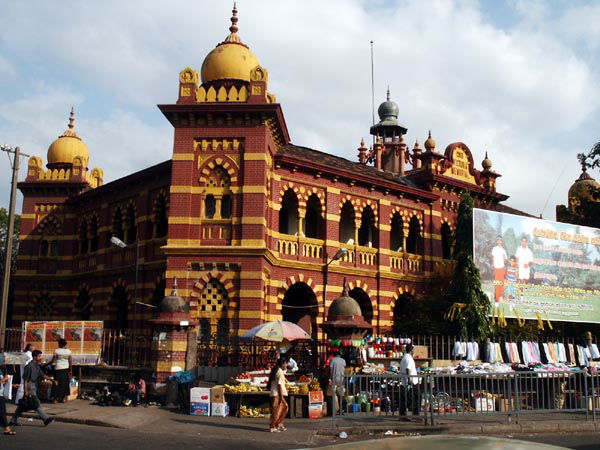The striking colour and structure of the Victoria Memorial Eye Hospital at De Soysa Circus, is an unmistakable landmark in Colombo city. It is with marvel that passers by pause for a moment to wonder at its history, purpose and its remarkable appearance.
Unfortunately, many are unaware that it is, actually, part of the Colombo National Hospital, and are under the misconception that it is an abandoned structure housing only insects and nocturnal creatures.

Postcard Colombo Ceylon Sri Lanka, Victoria Memorial, Eye Hospital 
Back of the Post Card 




The building was originally intended to be the Victoria Memorial Eye Hospital, but now houses coroner’s office, orthopaedic wards, vascular surgery, operating theatres and doctors’ duty rooms.
The upper most part of the building sports the lettering ‘1903 Victoria Memorial’. At the main entrance is a plaque denoting that the foundation stone was laid by Lady Ridgeway on August 6, 1903.
It is generally believed that the construction of the building was financed and later donated to the hospital by the great philanthropist Charles Henry de Soysa (1836–1890), whose statue is erected at the De Soysa Circus, directly in front of the building.
This red-brick colonial building is in the Indo-Saracenic style and it was designed by Colombo-based architect Edward Skinner. And it is believed that he was one of the architects involved in the renovations of Buckingham Palace
Yet, these facts are disputed. History does not provide a clear picture of the exact purpose or the benefactor behind the donation. The Eye Hospital was built to commemorate the Diamond Jubilee of Queen Victoria in 1897, seven years after de Soysa’s death. On the other hand, the plaque says the foundation stone was laid in 1903.
The building is rectangular with a tower sporting a dome at each corner. A smaller central dome can also be seen just above its name plate. The ground floor of the building has a front porch, with a verandah running around the building. Upon climbing to the second floor, a visitor is greeted with a breathtaking view from each side of the building.
The frontal view offers the sight of the heated city and the main road running towards Kollupitiya. The side views offer contrasting pictures: One quite different from the other. On one side is a departmental store catering to the luxury lives of the elite and on the other, thousands of commuters busily running towards the Colombo National Hospital. From the other balcony, the visitor is greeted by the back gardens, neatly kept by the hospital staff. There are also the new additions to the old structure.
The domes are quite interesting. On the second floor, inside each dome is a toilet – tiled in the ancient style, but kept quite clean. There are spiral staircases running to the ground floor behind those toilet doors. Staircases are covered with rust and years of non-use have gathered dust and cobwebs, giving the impression that it might give way under an unsuspecting visitor’s feet. However, the iron rungs supporting the steps proved to be quite intact and after brushing away the dust, an intricate design could be perceived. Two of the four domes hide such staircases, but they are no longer used by any of the occupants.
The front entrance to the building is no longer used. Instead, visitors have to enter from the orthopaedic unit at the back of the building and find their way towards the front. With several large trees covering the front porch, the vicinity provides a cool shade. Only feet ahead is the burning city. Yet, the contrast in temperatures is surprising. The two padlocked gates leading to Ward Place and E.W. Perera Mawatha also vent out signs of a bygone era.
In 1991, President Premadasa declared this building a protected site. It is a violation of the law to build any structure obstructing the view of the building. An overhead bridge built across E.W. Perera Mawatha, for the use of visitors to the National Hospital, was demolished, as it obstructed the Victoria Memorial.
Although, inside the building it is quite busy with surgical operations, the exterior of the building displays nothing more than decay and dilapidation. There is a plaque denoting that the building was renovated in 1997 by the then Health Minister. Lack of attention seems to be seeping into the building, ruining its unique architectural design. The ceiling is on the verge of collapse. There are stray cats and dogs that have made the vicinity their home. Just outside the premises is a horde of street vendors, who have set up their little boutiques, by using the iron fence of the building as support.
Victoria Memorial is a unique structure. The building and its architecture denote a bygone era in the history of the country. Although colonials are long gone, this remarkable monument should not be left to decay, as it is part of the identity of Colombo, the city of many contrasts.
Credit – The Nation, Sunday Observer, AKPool UK, Lankapura

















Loading…
Loading…